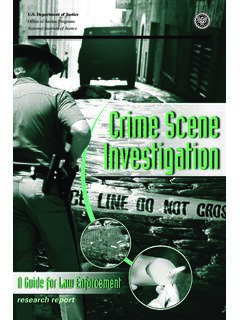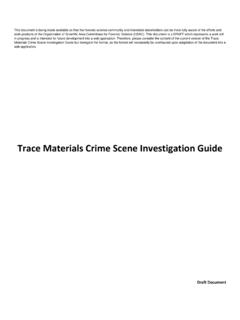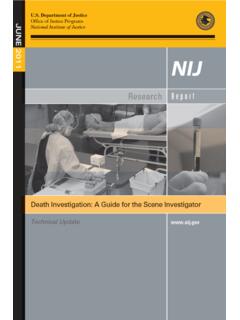Transcription of Crime Scene to Courtroom
1 OverviewThis Unit takes you on a journey through the criminal justice system. We begin with the initial investigation that takes place once a Crime is discovered and then we move through the different stages of arrest, prosecution and conviction of the offender, and finally to any appeal. We begin by looking at the roles of the different personnel involved once a Crime is detected, including police officers, Crime Scene investigators and forensics specialists. We examine the different techniques investigators use to gather evidence, including forensic laboratory analysis, surveillance, interviewing and offender profiling.
2 Once the evidence against a suspect has been collected, the Crown Prosecution Service has to decide whether to prosecute them. We consider how they reach their we look at the rights of suspects who are arrested, charged and tried, and the safeguards that aim to ensure they receive a fair trial. These safeguards include important rules about what kind of evidence is permitted in court. For example, hearsay evidence and confessions obtained by threatening the suspect are ruled out. Criminal trials may be held in a magistrates court or for more serious offences before a jury in the Crown Court.
3 We examine the role that ordinary citizens (laypeople) play as magistrates and jurors, including the factors that may influence a jury s verdict. For example, are jurors swayed by what they see on social media about the case they are trying? Miscarriages of justice occur when an innocent person is convicted of a Crime or when the trial itself was so unfair that we cannot be sure the defendant is guilty. In such cases, the court s verdict is unsafe and it may be overturned on appeal. When you have completed this Unit, you will be in a position to review criminal cases, evaluate the evidence and the trial process, and decide for yourself whether the verdict reached by a court is safe and Scene to CourtroomUNIT3 The key personnel in criminal investigationsIn this Topic, we look at the key personnel involved in investigating crimes and the roles they perform, and we examine the strengths and limitations of each of them.
4 The following personnel are the ones most closely involved in criminal investigations: Police officers are usually first on the Crime Scene and they secure it for investigation. Police detectives lead the investigation into the Crime . Crime Scene investigators gather and preserve evidence from Crime scenes for use in investigations. Forensic scientists examine, analyse and interpret Crime Scene evidence using their specialist knowledge and skills. Forensic pathologists specialise in establishing the causes of suspicious deaths. The Crown Prosecution Service makes the decision about whether to charge and prosecute a officersA police officer is usually the first person called to a Crime Scene and they have a vital role at the start of the investigation.
5 Officers need to safeguard the public and attend to anyone seriously injured at the Scene , for example by calling an emergency ambulance. If possible, they need to arrest the suspect, though in many cases they will have left the , as far as the investigation is concerned, the police officer s key job is to secure the Crime Scene in order to conserve the evidence. As far as possible they should avoid contaminating the Scene by moving furniture, opening doors etc. Police officers Go to the effectiveness of the roles of personnel involved in criminal investigationsGetting StartedWorking in small groups, imagine you are a member of the public at the Scene of a suspicious death.
6 What would you do and what do you think the procedure would be to deal with this Scene ? You could consider the following:1. What is your first action?2. Who would you expect to arrive at the Scene ?3. What would the personnel who attend the Scene be doing?UNIT 3 Crime Scene TO COURTROOMI nterviewsInterviewing witnesses to a Crime or interviewing forensic and other experts can be an important part of an investigation and court testimonyEye-witness testimony (EWT) is the evidence given by a witness to a Crime . Juries are often willing to accept EWT as an accurate account of an incident and they frequently give more weight to it than to other kinds of evidence.
7 For example, the Devlin Committee in 1976 found that juries convicted in 74% of cases where line-up identification was the only prosecution , their faith may be misplaced. For example, the Innocence Project in the USA has found that in over 70% of 352 wrongful convictions that were later overturned on the basis of DNA evidence, eye-witness misidentification played a role in convicting an innocent person including 15 cases where the person spent time on death row. Eye-witness testimony Go to problems of EWTMany of the problems with relying on EWT concern witnesses memories.
8 There are three aspects to memory: acquisition: witnessing the Crime and absorbing what is happening retention: storing the information in the memory retrieval: recalling the memory, when being interviewed by police or identifying someone in a against undercover police who infiltrated peaceful protest movements over a 24-year 3 Crime Scene TO COURTROOMBy carefully analysing the Crime Scene , it may be possible to identify the type of offender and their likely characteristics, such as their personality, lifestyle, relationships and motives. The profiler therefore gathers all the available information about the Crime Scene , the victim and the forensic evidence.
9 Typological profiling divides Crime scenes and offenders into two types: organised and disorganised. The table uses the example of murder cases to show the difference between the two of murderLikely characteristics of the murdererOrganised Crime The Crime is planned, murderer takes weapon and restraints to the Crime Scene Attempts to control the victim Leaves few clues at the Crime Scene (removes evidence) The victim is a targeted murderer Above average intelligence (but possibly an underachiever) Manipulative, cunning, outwardly normal, concealing sadistic personality Socially and sexually competent Usually living with a partner Angry/depressed at time of the attack Follows media coverage of the Crime Spontaneous little planning or preparation, weapon improvised at the Crime Scene Random, disorganised behaviour Minimum use of constraint Little attempt to hide evidence at the Crime Scene , leaves murder weapon murderer Lives alone.
10 Near to the Crime Scene Sexually and socially inadequate Suffers severe forms of mental illness Physically or sexually abused in childhood Frightened and confused at time of the profile can then be used by police to identify likely suspects and narrow down their search. It can also be used to predict the likely future behaviour of the offender, such as whether and where they might strike profiling was originally developed in the 1970s in the USA by the FBI. Since then, further typologies have been developed to classify rapists, based on their behaviour when offending.











